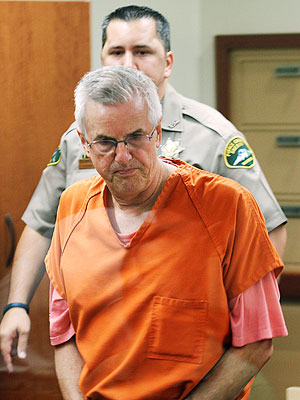Airport food in L.A. has been so bad for so long it's no longer brought up in polite society. Only at LAX could the 2010 arrival of Pink's hot dogs — and God love 'em, I know I do — have been welcomed like Moses coming down off the mountain.
"It's like the smog: Why complain? Everybody knows," chef Mark Peel told me last week.
Since we began having to schlep wretched little bags of food on the plane or starve, the smell of rancid oil and Flamin' Hot Cheetos has made the LAX experience unpleasant in all five senses. But all that is about to change.
LAX is opening its doors starting this year to some of the city's signature restaurants, including Larder at Tavern, Cole's and Ford's Filling Station. A rotating cast of food-truck vendors including Kogi's is expected to operate out of a space with a mock truck decor. Peel, who closed Campanile on La Brea Avenue in the fall after 23 years, is opening an airport version of the high-class restaurant. The lucky terminals include Tom Bradley International and Terminal 4, home to American Airlines.
What makes this of interest outside foodie circles is that, unlike other gentrification schemes, it will not cost all the little people their jobs. The city, through the Unite Here Local 11 union, is spending $250,000 to retrain workers displaced from eateries like Burger King and Chili's to work in the new culinary palaces.
Last week, I took a turn through the clattering kitchen where the training has been underway since October. The kitchen, along with a cafeteria, is on the ground floor, beneath the struts that thrust the flying-saucer themed restaurant Encounter into the air above LAX.
Inside, 52 cooks from South Los Angeles, Carson, Inglewood and other airport-adjacent neighborhoods were practicing haute cuisine. Workers in white toques and chef jackets grated lemon zest, snipped herbs and squeezed potato croquettes out of pastry tubes. Plates of egg rolls with dipping sauce, salmon with field greens or carnitas with salsa fresca were passed around. Peel, who has appeared on "Top Chef" and "Top Chef Masters," dropped by to give an inspirational speech.
"This is where we're trying to give people a much better first impression of LA, and you're it," he said.
Leanna Billman told me the closest she got to cooking on the Burger King fry line was flipping frozen chicken strips on the grill. Now she's learning to braise meat, shuck oysters and slice vegetables in fancy cuts like paysanne and rondelle.
"I grew up kind of in poverty," said the South Los Angeles resident. "Now I'm in an actual kitchen instead of behind a sandwich grill. It's great."
Janette Perez, 21, a former Ruby's server, grew up in Inglewood on Mexican food, french fries and chicken, but learned to make Caesar salad dressing with anchovies for her family.
"I didn't know they were fish, " Perez said. "These talents I thought I didn't have are really coming out."
Former Ruby's cashier Eric Rendon rides the bus in from Inglewood, dressed in his chef's whites. His fellow riders treat him with new respect, he said.
"My family is really proud of me," said Rendon, 19.
Peel's speech to the cooks covered how once-fertile African land became the Sahara Desert because of unsustainable farming practices. It went over some of their heads.
"Sustainability, sustainability," Perez repeated afterward, stumped. But she is excited about cooking healthier. "We're not eating enough fresh food," she said. "Everything we eat is fattening."
Peel said a modern kitchen staff should understand the importance of sustainability along with more traditional culinary skills. Peel's first culinary job was fry cook at Cindy's, "where the 605 meets the Pomona Freeway," Peel said. "Everybody's got to start somewhere."
The LAX Campanile will have sit-down dining as well as takeout, Peel told a small group gathered around one of the prep tables, prompting a teaching chef from Los Angeles Trade Technical College to joke he'd have to find a way around security so he could eat there. But passengers on average have only 12 minutes to get in and out of the terminal.
Peel said he could still serve high-end dishes like ribeye with stewed beans through innovations like sous-vide, in which plastic-wrapped food cooks slowly in a water bath. As an example, Peel said he would marinate and brine a double-thick pork chop, put it in the bath, then when an order came in, throw it over a wood fire or grill to give it a char. The chop could be out in four minutes, he said.
This kind of food is not going to come cheap. The retrained workers will command better wages, and more staff will be needed in the kitchen; a spokeswoman said the union expects its membership to double.
Rest assured, LAX will always have its burgers with fries.
"There's always going to be a place for fast food," Peel said. "But we have an opportunity for much greater diversity.... The way we're going to do that is with a highly trained, motivated and intelligent work force."
Valencia Crain, 49, has run the gamut of food service jobs, starting out on the production line at a fish processing plant in Los Angeles. She cut fish and passed them through batter, monitoring the viscosity meter to make sure it wasn't too watery.
Later, she worked at the airport LA Roadhouse Route 66, where much of the cooking consisted of microwaving. Now, she's learned how to prepare a dashi base and clear broth for Japanese soup, and clam chowder from scratch, which she put to the ultimate test: her son, Samej. The 16-year-old is part of the fiercest fast-food fan demographic on earth: the L.A. teenager.
The soup more than passed.
"When he tasted mine he said, 'Mom, yours is the best in the world,'" Crain said.
gale.holland@latimes.com













